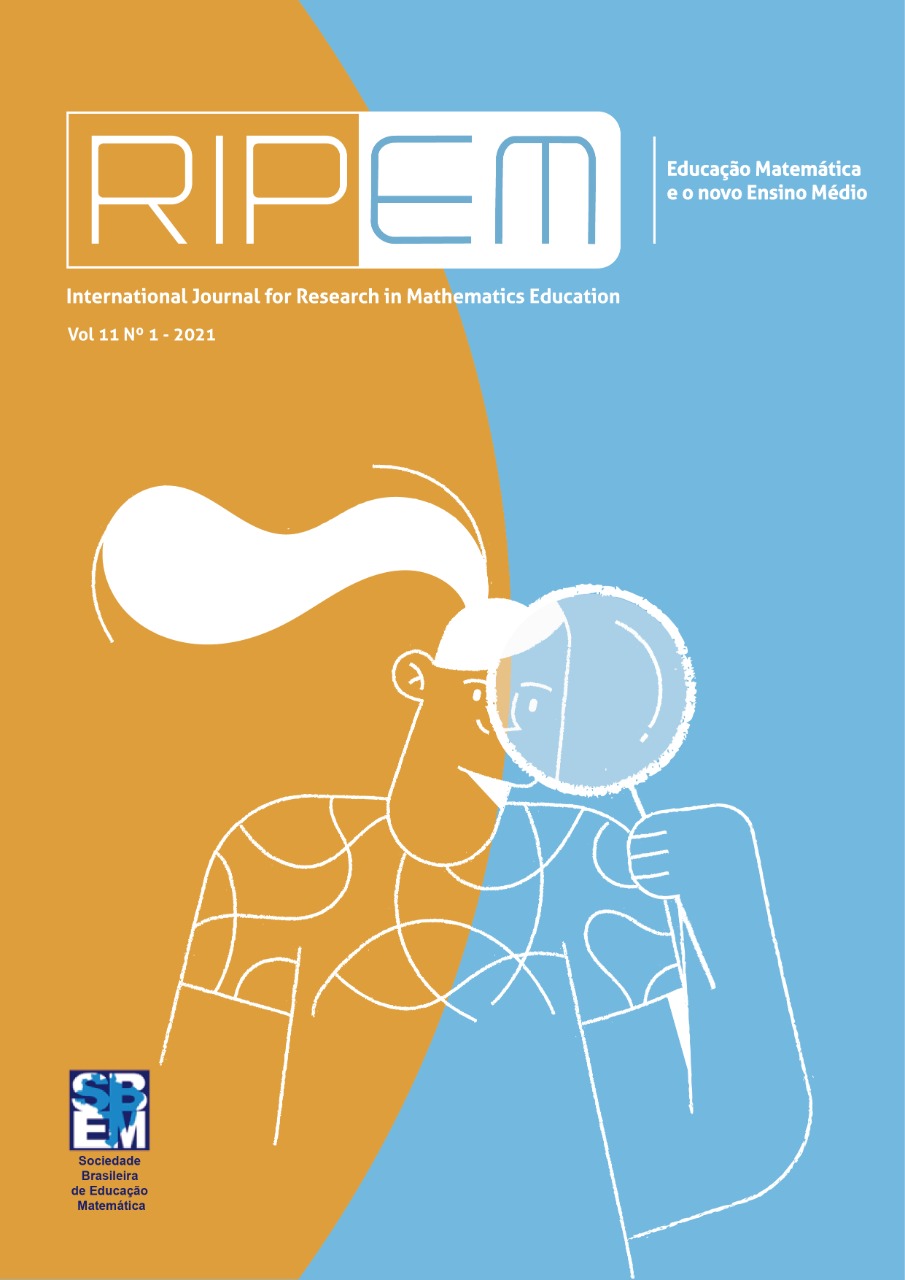New content and new skills for the area of Mathematics and its Technologies
DOI:
https://doi.org/10.37001/ripem.v11i1.2539Keywords:
Textbook, High School, Curricular Standards, Computational Thinking, Map projectionsAbstract
It is fundamental for schools to understand policy. However, teachers and staff are constantly surprised by educational policies that affect entire schools. For that reason, it is important to reflect and discuss this issue. In this context, a group of professors, researchers and teachers is working on developing a Mathematics textbook for High School fully aligned with the new Brazilian Curricular Standards (BNCC) and the new regulations for High School (NEM). The aim of this paper is to present the discussions that took place during the development of two chapters of this textbook as well as the design principles and general features of them. One of the chapters is about map projection and the other is about computational thinking. Regarding the latter, BNCC focused exclusively on algorithmic thinking and limited the presence of the topic within Mathematics skills and competences, which is also observed for map projections. Considering that BNCC and NEM are already in place, this paper discusses the implications of including such new topics in the mathematics curriculum. Finally, the authors present some activities that teachers can use in their classroom as a way to start exploring these topics.
Downloads
References
Almeida, R. D. de. (2001). Do desenho ao mapa: iniciação cartográfica na escola. São Paulo: Contexto.
Andrade, M. C. P., & da Motta, V. C. (2020). Base nacional comum curricular e novo ensino médio. Revista HISTEDBR On-line, v.201-26.
Battersby, S. E., & Kessler, F. C. (2012). Cues for interpreting distortion in map projections. Journal of Geography, 111(3), 93-101.
Brackman, C. P.; Barone, D.A.C.; Casali, A. & Román-González, M. (2020) Panorama global de adoção do pensamento computacional. In: Raabe, A.; Zorzo, A. F.& Blikstein, P. Computação na Educação Básica: Fundamentos e Experiências. Porto Alegre: Penso Editora.
Brasil, Ministério da Educação (2019). Base nacional comum curricular. BrasÃlia, DF,
Castro, G.A.M., Santo, C.F.A.E., Barata, R. C., Almouloud, S. A. (2020). Desafios para o professor de Ciências e Matemática revelados pelo estudo da BNCC do Ensino Médio. Revista Eletrônica de Educação Matemática -Revemat, Florianópolis, v. 15, p. 01-32.
Costa, M. O., Silva, L. A. (2019). Educação e democracia: Base Nacional Comum Curricular e novo ensino médio sob a ótica de entidades acadêmicas da área educacional. Revista Brasileira de Educação, v. 24.
De Oliveira, C. P., Silva, E. F. (2020). O (des) lugar do ensino médio na educação básica. Revista Cadernos de Educação Básica, v. 5, n. 1, p. 21-34.
DiSessa, A. A. (2018). Computational literacy and “the big picture†concerning computers in mathematics education. Mathematical thinking and learning, 20(1), 3-31.
Farias, P. S. C. (2017). A reforma que deforma: o novo ensino médio e a Geografia. Pensar Geografia, 1(2), 129-149.
Ferreira, F., Abreu, R. J., & Louzada-Silva, D. (2020). Desafios da articulação entre o novo ensino médio e a BNCC: o caso do Distrito Federal. Em Aberto, 33(107).
Ghaderpour, E. (2016). Some Equal-area, Conformal and Conventional Map Projections: A Tutorial Review. Journal of Applied Geodesy, 10(3), 197-209.
GISGeography, 2015. 10 Open Source Remote Sensing Software Packages.
Li, Y. et al. (2020). Computational Thinking Is More about Thinking than Computing. Journal for STEM Education Research, 1–16.
Lorenzato, S. (2006). Para aprender matemática. Campinas: Autores Associados.
Lunkes, R. P.; Martins, G. (2012) Alfabetização cartográfica: um desafio para o ensino de geografia. Origem não identificada.
Ludwig, A. B., & Nascimento, E. (2016). os conhecimentos cartográficos na prática docente: um estudo com professores de geografia. Caminhos de geografia, 17(60), 183-196.
Mainardes, J. (2006). Abordagem do ciclo de polÃticas: uma contribuição para a análise de polÃticas educacionais. Educação & Sociedade, 27(94), 47-69.
Novak, J. D. (1984) Aprender a aprender. Cambridge University Press.
Novak, J. D., Rabaça, A., & Valadares, J. (2000). Aprender criar e utilizar o conhecimento: Mapas conceptuais TM como ferramentas de facilitação nas escolas e empresas. Lisboa. Plátano Edições.
Nussbaum, J., & Novak, J. (1976). An assessment of children's concepts of the earth utilizing structured interviews. SciEd, 60(4), 685-691.
SBC. (2018). “Nota Técnica da Sociedade Brasileira de Computação sobre a BNCC-EF e a BNCC-EM, Sociedade Brasileira de Computaçãoâ€.
Snyder, J. P., & Voxland, P. M. (1989). An album of map projections (No. 1453). US Government Printing Office.
Wiggins, G., & McTighe, J. (2019). Planejamento para a Compreensão-: Alinhando CurrÃculo, Avaliação e Ensino por Meio da Prática do Planejamento Reverso. Penso Editora.
Published
How to Cite
Issue
Section

This work is licensed under a Creative Commons Attribution-NonCommercial-NoDerivatives 4.0 International License.








